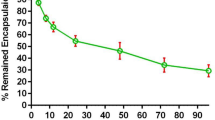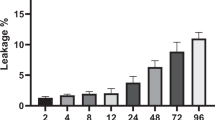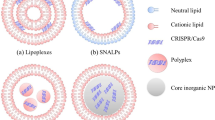Abstract
Phosphorothioate c-myc antisense oligodeoxynucleotides [S]ODNs (free INX-6295) were encapsulated in a new liposome formulation and the antitumor activity was compared to the unencapsulated antisense in a human melanoma xenograft. The systemic administration of INX-6295 encapsulated in stabilized antisense lipid particles (SALP INX-6295) improved plasma AUC (area under the plasma concentration–time curve) and initial half-life of free INX-6295, resulting in a significant enhancement in tumor accumulation and improvement in tumor distribution of antisense oligodeoxynucleotides. Animals treated with SALP INX-6295 exhibited a prolonged reduction of c-myc expression, reduced tumor growth and increased mice survival. When administered in combination with cisplatin (DDP), SALP INX-6295 produced a complete tumor regression in approximately 30% of treated mice, which persisted for at least 60 days following the first cycle of treatment. Finally, the median survival of mice treated with DDP/SALP INX-6295 increased by 105% compared to 84% for animals treated with the combination DDP/free INX-6295. These data indicate that the biological activity and the therapeutic efficacy of c-myc antisense therapy may be improved when these agents are administered in lipid-based delivery systems. Cancer Gene Therapy (2001) 8, 459–468
This is a preview of subscription content, access via your institution
Access options
Subscribe to this journal
Receive 12 print issues and online access
$259.00 per year
only $21.58 per issue
Buy this article
- Purchase on Springer Link
- Instant access to full article PDF
Prices may be subject to local taxes which are calculated during checkout
Similar content being viewed by others
References
Crooke ST . An overview of progress in antisense therapeutics Antisense Nucleic Acid Drug Dev 1998 8: 115–122
Akhtar S, Agrawal S . In vivo studies with antisense oligonucleotides Trends Pharmacol Sci 1997 18: 12–18
Smith JB, Wickstrom E . Preclinical antisense therapy of cancer in mice Methods Enzymol 2000 314: 537–580
Stevenson JP, Yao K-S, Gallagher M, et al . Phase I clinical/pharmacokinetic and pharmacodynamic trial of the c-raf-1 antisense oligonucleotide ISIS 5132 (CGP 69846A) J Clin Oncol 1999 17: 2227–2236
Nemunatitis J, Holmlund JT, Kraynak M, et al . Phase I evaluation of ISIS 3521, an antisense oligodeoxynucleotide to protein kinase C-alpha in patients with advanced cancer J Clin Oncol 1999 17: 3586–3595
Waters JS, Webb A, Cunningham D, et al . Phase I clinical and pharmacokinetic study of Bcl-2 antisense oligonucleotide therapy in patients with non-Hodgkin's Lymphoma J Clin Oncol 2000 18: 1812–1823
Gokhale PC, Soldatenkov V, Wang F-H, Rahman A, Dritschilo A, Kasid U . Antisense raf oligodeoxynucleotide is protected by liposomal encapsulation and inhibit Raf-1 protein expression in vitro and in vivo : implications for gene therapy of radioresistant cancer Gene Ther 1997 4: 1289–1299
Gokhale PC, McRae D, Monia BP, et al . Antisense raf oligodeoxyribonucleotide is a radiosensitizer in vivo Antisense Nucleic Acid Drug Dev 1999 9: 191–201
Pagnan G, Stuart DD, Pastorino F, et al . Delivery of c-myb antisense oligodeoxynucleotides to human neuroblastoma cells via disialoganglioside GD 2-targeted immunoliposomes: antitumor effects J Natl Cancer Inst 2000 92: 253–261
Stuart DD, Kao GY, Allen TM . A novel, long-circulating, and functional liposomal formulation of antisense oligodeoxynucleotides targeted against MDR1 Cancer Gene Ther 2000 7: 466–475
Gutierrez-Puente Y, Tari AM, Stephens C, Rosenblum M, Guerra RT, Lopez-Berestein G . Safety, pharmacokinetics, and tissue distribution of liposomal P-ethoxy antisense oligonucleotides targeted to Bcl-2 J Pharmacol Exp Ther 1999 291: 865–869
Semple SC, Klimuk SK, Harasym TO, Hope MJ . Lipid-based formulations of antisense oligonucleotides for systemic delivery applications Methods Enzymol 2000 313: 322–341
Semple SC, Klimuk SK, Harasym TO, et al . Efficient encapsulation of antisense oligonucletides in lipid vesicles using ionizable aminolipids: formation of novel small multilamellar vesicle structures Biochim Biophys Acta 2001 1510: 152–166
Leonetti C, D'Agnano I, Lozupone F, et al . Antitumor effect of c-myc antisense phosphorothioate oligodeoxynucleotides on human melanoma cells in vitro and in mice J Natl Cancer Inst 1996 88: 419–429
Citro G, D'Agnano I, Leonetti C, et al . c-myc antisense oligodeoxynucleotides enhance the efficacy of Cisplatin in melanoma chemotherapy in vitro and in nude mice Cancer Res 1998 58: 283–289
Leonetti C, Biroccio A, Candiloro A, et al . Increase of Cisplatin sensitivity by c-myc antisense oligodeoxynucleotides in a human metastatic melanoma inherently resistant to Cisplatin Clin Cancer Res 1999 5: 2588–2595
Geran RI, Greenberg NH, Macdonald MM, Shumacher AM, Abbott BJ . Protocols for screening chemical agents and natural products against animal tumors and other biological systems Cancer Chemother Rep, Part 3 1972 3: 1–88
Garbo C . Chemotherapy and chemoimmunotherapy in disseminated malignant melanoma Melanoma Res 1993 3: 291–299
Coates AS, Segelov E . Long term response to chemotherapy in patients with visceral metastatic melanoma Ann Oncol 1994 5: 249–251
Middleton MR, Lorigan P, Owen J, et al . A randomized phase III study comparing dacarbazine, BCNU, cisplatin and tamoxifen with dacarbazine and interferon in advanced melanoma Br J Cancer 2000 82: 1158–1162
Jansen B, Schlagbauer-Wadl H, Brown BD, et al . bcl-2 antisense therapy chemosensitizes human melanoma in SCID mice Nat Med 1998 4: 232–234
Fingert HJ, Klem RE . Clinical and pharmacodynamics of G3139 (Genta Incorporated) antisense oligonucleotide targeting BCL-2 Proc AACR-NCI-EORTC International Conference “Molecular Targets and Cancer Therapeutics” 1999 Abstract 585
Jansen B, Wacheck V, Heere-Ress E, et al . Systemic treatment with bcl-2 antisense down-regulates tumor content of bcl-2 protein and induces major antitumor responses in patients with melanoma when combined with dacarbazine Proc Am Assoc Cancer Res 2000 LB-23
Mayer LD, Bally MB, Cullis PR, Wilson SL, Emerman JT . Comparison of free and liposome encapsulated doxorubicin tumor drug uptake and antitumor efficacy in the SC115 murine mammary tumor Cancer Lett 1990 53: 183–190
Bakker-Woundenberg LA, ten Kate MT, Stearne-Cullen LE, Woodle MC . Efficacy of gentamicin or ceftazidime entrapped in liposome with prolonged blood circulation and enhanced localization in Klebsiella pneumonia –infected lung tissue J Infect Dis 1995 171: 938–947
Forssen EA . The design of Daunoxome(R) for solid tumor targeting in vivo Adv Drug Delivery Rev 1997 24: 133–150
Valero V, Buzdar AU, Theriault RL, et al . Phase II trial of liposome-encapsulated doxorubicin, cyclophosphamide, and fluorouracil as first-line therapy in patients with metastatic breast cancer J Clin Oncol 1999 17: 1425–1434
Cheung TW, Remick SC, Azarnia N, Proper JA, Barrueco JR, Dezube BJ . AIDS-related Kaposi's sarcoma: a phase II study of liposomal doxorubicin. The TLC D-99 Study Group Clin Cancer Res 1999 5: 3432–3437
Boman NL, Masin D, Mayer LD, Cullis PR, Bally MB . Liposomal vincristine which exhibits increased drug retention and increased circulation longevity cures mice bearing P388 tumors Cancer Res 1994 54: 2830–2833
Boman NL, Bally MB, Cullis PR, Mayer LD, Webb MS . Encapsulation of vincristine in liposome reduces its toxicity and improves its anti-tumor efficacy J Liposome Res 1995 5: 523–541
Webb MS, Harasym TO, Masin D, Bally MB, Mayer LD . Sphingomyelin-cholesterol liposome significantly enhance the pharmacokinetic and therapeutic properties of vincristine in murine and human tumor models Br J Cancer 1995 72: 896–904
Gelmon KA, Tolcher A, Diab AR, et al . Phase I study of liposomal vincristine J Clin Oncol 1999 17: 697–705
Sarris AH, Hagemeister F, Romaguera J, et al . Liposomal vincristine in relapsed non-Hodgkin's lymphomas: early results of an ongoing phase II trial Ann Oncol 2000 11: 69–72
Klimuk SK, Semple SC, Scherrer P, Hope MJ . Contact hypersensitivity: a simple model for characterization of disease-site targeting by liposome Biochim Biophys Acta 1997 1328: 261–272
Klimuk SK, Semple SC, Nahirney PN, et al . Enhanced anti-inflammatory activity of a liposomal intercellular adhesion molecule-1 antisense oligodeoxynucleotide in an acute model of contact hypersensitivity J Pharmacol Exp Ther 2000 292: 480–488
Henry SP, Giclas PC, Leeds J, et al . Activation of the alternative pathway of complement by a phosphorothioate oligonucleotide: potential mechanism of action J Pharmacol Exp Ther 1997 281: 810–816
Acknowledgements
Barbara Benassi is recipient of a fellowship from Italian Foundation for Cancer Research (FIRC).
The authors thank Marco Scarsella for expert technical assistance in animal experiments, Simona Righi for excellent secretarial support, and Mauro Di Giovanni for photographic assistance.
This work was partially supported by Italian Association for Cancer Research (AIRC), Ministero della Sanità, and Progetto Strategico Murst-CNR.
Author information
Authors and Affiliations
Corresponding author
Rights and permissions
About this article
Cite this article
Leonetti, C., Biroccio, A., Benassi, B. et al. Encapsulation of c-myc antisense oligodeoxynucleotides in lipid particles improves antitumoral efficacy in vivo in a human melanoma line. Cancer Gene Ther 8, 459–468 (2001). https://doi.org/10.1038/sj.cgt.7700326
Received:
Published:
Issue Date:
DOI: https://doi.org/10.1038/sj.cgt.7700326
Keywords
This article is cited by
-
Electroporation increases antitumoral efficacy of the bcl-2 antisense G3139 and chemotherapy in a human melanoma xenograft
Journal of Translational Medicine (2011)
-
Encapsulation in liposomal nanoparticles enhances the immunostimulatory, adjuvant and anti-tumor activity of subcutaneously administered CpG ODN
Cancer Immunology, Immunotherapy (2007)
-
Antitumor effects of radioiodinated antisense oligonuclide mediated by VIP receptor
Cancer Gene Therapy (2005)
-
RAF antisense oligonucleotide as a tumor radiosensitizer
Oncogene (2003)
-
The future of antisense therapy: combination with anticancer treatments
Oncogene (2003)



